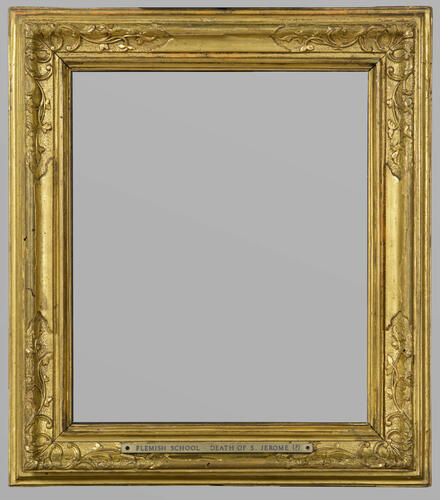-
1 of 253523 objects
Frame for RCIN 402993, van Diepenbeck, The Death of St Anthony Abbot mid-18th-century
Carved and oil-gilded | 36.5 x 32.3 x 4.0 cm (frame, external) | RCIN 7402993

Masters of the Consul Smith picture frames (mid 18th century)
Frame for RCIN 402993, van Diepenbeck, The Death of St Anthony Abbot mid-18th-century
-
A remarkable number of paintings acquired by George III in 1762 from the collection of Consul Joseph Smith, have remained in the original Venetian frames chosen by Smith himself. The majority of Smith’s frames are of a Venetian ‘panel’ type, characterised by an elegant rococo moulding of carved leaf, flower and ‘C’ scroll ornament, with plain panels (from which the name derives) in the centre. This pattern was typically used during this period for both pictures and mirrors. Smith used such frames, not only for his contemporary Venetian pictures, but also for earlier Italian and Northern School paintings. No distinction was made between the subject-matter; portraits, landscapes, religious and mythological subjects - all were similarly framed.
There are three distinct variations of the Venetian panel type found in Smith’s collection. The largest group has a distinctive ‘dentil’ or tooth-like decoration on the sight edge which sometimes varies in size, depending on the scale of the painting. The carving of these frames is usually of high quality and the uniformity would suggest they were made by one frame-maker (see RCIN 7401073, for example). It has been suggested that this may be the result of a reframing campaign by Smith from the 1740s or early 1750s when he was decorating and furnishing his palazzo at SS Apostoli.
The second variation can be seen around the series of six large paintings by Sebastiano Ricci of scenes from the New Testament; this has a distinctive textured sight decoration, and the carving appears less refined, harking back to a baroque tradition of carving, and suggesting a date in the 1720s, contemporary with the paintings (RCIN 7405739). However, some of these frames appear to have been cut though the moulding in the centres at some point (RCINs 7405742, 7405743), suggesting they may not be original to the paintings. Alternatively, and a more likely explanation for this is that the frame may have been cut at some point to facilitate transport or to allow them to pass through a doorway.
The third style framed many of the gouaches by Marco Ricci; these have a leaf-and-tongue decoration to the sight edge and are more broadly carved, giving an appearance typical of Venetian frames of this period. They may be contemporary with the gouaches, suggesting a date of c. 1717-30 (for example RCIN 7400577).
Of these frames, approximately thirty received composition additions in the nineteenth century. Composition is a mixture of whiting (chalk), glue, resin and linseed oil which can be pressed to make moulded ornament; first developed in London in the late eighteenth century, it allowed a variety of ornament to be created more swiftly and cheaply than carved decoration. In 1828 George IV moved a number of Smith’s pictures (notably works by Canaletto and Zuccarelli) to Windsor and their frames were enriched and enlarged by Joseph Crouzet in order to be incorporated into Jeffry Wyatville’s new decorative scheme for the Grand Corridor at Windsor Castle.
A fourth style of a C-scroll pattern was chosen by Smith for his series of paintings of the Grand Canal by Canaletto All the frames of this type received composition additions in the early nineteenth century (for example RCIN 7400518).
Text adapted from A King’s Purchase and the Collection of Consul Smith, London 1993
-
Creator(s)
-
Medium and techniques
Carved and oil-gilded
Measurements
36.5 x 32.3 x 4.0 cm (frame, external)
28.0 x 23.7 x 1.5 cm (frame, rebate)
26.8 x 22.4 cm (sight)
5.0 cm (Width) (frame, rebate)
Category
Object type(s)